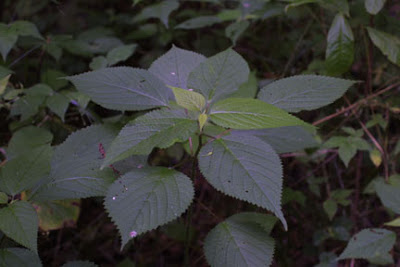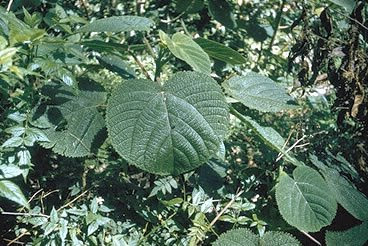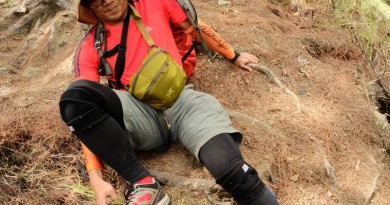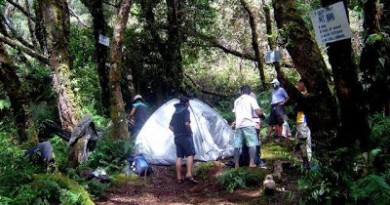Lipa (tropical wood nettles): an overview
by Gideon Lasco
 This is an article belonging to the ‘climb health‘ category in PinoyMountaineer. Information provided in this article are based on research and are not meant as a substitute to actual medical advice and healthcare.
This is an article belonging to the ‘climb health‘ category in PinoyMountaineer. Information provided in this article are based on research and are not meant as a substitute to actual medical advice and healthcare.
Tropical wood nettles from the genus Laportea – known simply as the lipa in Tagalog; in other languages lupa, dalamo, lingaton – are a notorious breed of plants that release a poisonous substance that causes intense irritation to the skin, which include a burning sensation or severe itchiness, rashes, among others. Mountaineers know this, and in fact have a folk remedy for this: the application of duct tape to remove the poison.
As early as the 1930s, our wood nettles have gained notoriety to foreigners. The famous American botanist David Fairchild reports that he experienced “intense pain lasting for days” in his fingertips when he touched such a plant, and anecdotally we are told that some unwitting Japanese soldiers who used lipa to wipe off their asses in the war got the worst torture of their lives!
It is important to note that this is a family of plants; som may be worse than others. This article aims for the identification and avoidance of these noxious plants, and if unable to, we should also deal with first aid and treatment.
IDENTIFYING THE LIPA PLANT
The Department of Agricutlure website describes a represetative plant as follows: “It is a dioecious shrub or small tree, reaching a height of 3 to 5 meters. The leaves are ovate to broadly elliptic-ovate, 20 to 40 centimeters long, 10 to 22 centimeters wide, entire, shortly pointed at the tip, and somewhat heart-shaped at the base. The upper surface is green, and smooth, and the lower one, paler and rather densely covered with soft hairs.” It is added, “The leaves have very numerous, conspicuous, stinging hairs. These hairs have a large bulbous base from which projects a long tapering tube that ends in a curved tip, which is so constructed that it breaks off easily. When one comes in contact with the leaves, the tips of the hairs are broken off and the poison injected. This causes intense irritation. “

PHOTOS: (COVER) Copyright (c) 2002 Steve Baskauf (3) Taken from www.stuartxchange.com. Rights reserved by owners.
AVOIDING THE LIPA PLANT
Prevention is better than treatment, and this is very true when it comes to lipa. When you are hiking in a mountain or passing by a trail known to have lipa, better have protective clothing (pants, long-sleeved shirts, rashguards, leggings, etc.). Be vigilant when climbing and try to avoid holding/touching plants or shrubs.
MOUNTAINS WITH LIPA PRESENCE
Just like other lists in the website, moutaineers are encourage to add/edit/comment on this partial listing
Mt. Makiling
Mt. Cristobal
Mt. Malipunyo
FIRST AID AND TREATMENT
First aid. After the sting, make sure that the affected area is clean, not dirty or muddy. Use water or alcohol to cleanse the affected skin but do not rub it lest the stinging hairs spread to other nearby areas.
In other countries, the dock plant – a plant which grows near nettles, is used as a immediate treatment; the sap of its stem is applied on the affected part. In the Philippines, a plant with similar effect would be the pungapong or elephant-foot yam. However, these options will not always be able for the hiker.
A local hiking tradition is to use adhesive tape, preferably duct tape. It is applied on the affected area for 5-10 seconds, then removed. Since the poison comes from stinging hairs, this technique could theoretically pull out the irritating hairs through adhesion, thereby lessening the poison that the body would absorb. Correlating our knowledge of the poison’s mechanism, this must be done within 10 minutes of the sting.
Home care. Once home, an antihistamine may be taken once or twice daily to lessen the urticaria (skin allergic response). This will also relieve itch and discomfort. A warm bath would be helpful in releasing the toxins.
Other remedies that have been suggested include alkalines such as baking soda (the logic is that the toxin is acidic therefore it has to be neutralized). Still, some suggests the use of urine and saliva. We have no data to recommend or refute these.
PROGNOSIS
Depending on the type of nettle, the discomfort should be gone within 12-72 hours. Other types may persist to 7-14 days. But 99.9% of the time the discomfort is relieved without complications, so there is nothing to worry about.
CONCLUSION
Limatik is to fauna as lipa is to flora; while the former has no long-term affects, the latter could be bothersome for several days after the climb. Hence the need to describe and avoid these types of plants, and understand the possible steps in treatment. We encourage hikers/readers of the blog to contribute to our knowledge about lipa so we can be better prepared in the future.
This is a constantly updated article. Everyone is invited to contribute and challenge the information given here by both the blogger and the those who posted their comments.







Leave a Reply
11 Comments on "Lipa (tropical wood nettles): an overview"
Hi Sir, I want to impart something as lipa leaf doesn't produced poison po. the itchiness is caused by specialized appendages of the plant which common referred to us Biologist as "Trichomes". In layman's term po is "maliliit na buhok" in bikol term po "Hibu". I don't know what they called it in tagalog po kasi hehe. but trichomes is a microscopic hairs of the plants and certain protists which is barely the same na makikita sa bamboo tree. its function po talaga sa plant is to gather nitrogen, O2 and other pertinent gas uptake from the leaves, di naman po talaga sya built or design to caused itchiness, kaya lang naman sya nagiging makati kasi sa sobrang minute or liit ng trichomes pumapasok ito sa epidermis and once na pumasok ito sa pores ng balat natin nababali yung tip o dulo ng trichomes na naiiwan naman sa sebaceous gland natin. kahit subukan nyo po hawakan using your palm hindi kayo mangangati kasi di kaya mapenetrate ng trichomes ang callus unlike sa bare skin. 🙂 ang First aid namin dyn is running water lang po or coconut milk. wag po kamutin o pagpagin using cloths kasi mamabali yung dulo ng trichomes. normally, pagnalipa kayo it would last for 3 days lang naman. natutunaw din kasi yung mga strand pag nagrelease ng oil yung sebum na part ng sebaceous. hope makatulong ito sa fellow mountaineers.:) _Marvz of SILANG mountaineer- Residence Biologist of Catanduanes, Bicol region
Hi Sir,
Just yesterday, nadale ako ng Lipa leaf sa Majayjay Laguna. Kinapitan ko sya na parang baging kaya grabe ang tama ng kamay ko, hanggang sa namaga both hands. As first aid (wala akong makitang alcohol) yung baon naming emperador ang binuhos ko, nare relax pagkatapos ibuhos pero sumasakit uli habang natutuyo. Sabi ng locals, langis daw ipahid. Nabawasan lang yung irritation sa langis pero masakit parin. Ginawa ko ponstan nalang hanggang sa makauwi. Now I know kung ano additonal first aid kit ang dapat ko dalhin (such as tape and antihistamine). Ayaw ko ng maulit kasi sobrang sakit but in case, I'll try to use my pee and I will get back here para patunayan na effective 🙂
ang FA po dyan s leaves n yan eh first wak mong kakamutin, common reaction ng katawan ntin pag n irritate and skin ay kamutin. remember s mountainerering pag may n feel k kgad n irritation, always remember wag kamutin…check mo part ng katawan mo kgad n n irritate. possible kc may insect dun o kung wla kng nkita on ur skin, possible n tamaan k nga ng anything n dahon n nkakairritate. u will not see anything on ur skin coz, posible powder or very small stinger ang nandun. Vinegar is commonly used FA for all of DAHON irritation dito s pinas, dhil s may chemical ito n kung stinger ang nsa skin mo ay kya nyang prevent n hndi to lumabas, kya pag nkakamot ntin n pu-pushed ntin ung poison s skin ntin. instinct lng n wag kamutin kgad pag may n feel kng bglang n ngati!
hello gid,
on my trip to biak na bato last year, our guide pointed to me a lipa tree (Laportea sp.)underneath the bridge to photograph. she knew i was taking photos of the interesting trees there. it's a good thing that the leaves were far beyond my reach or else it would have been an unfortunate experience cause i always take samples for close up photo and to take notes from. It was the lone lipa we saw at the length of the trail.
rey
second and third pic is not lipa leaves though it belong to the same genera it doesnt irritate or the make skin itchy